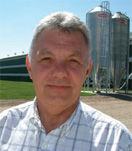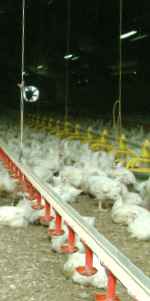
Adding More Value
 "We're always looking to add more value— that's the key."
"We're always looking to add more value— that's the key."
DR. RAE FISCHER
Nearly 3 years ago, Dr. Rae Fischer made what some
people in the broiler industry might have called a very brave
decision. Others might have said it was foolhardy.
The innovative CEO of Fisher Feeds¹,
Listowel, Ontario, decided to stop using
in-feed anticoccidials at his company's
feed mill, which produces 100,000 tons
of feed per year—about two-thirds
for poultry.
About half of the poultry feed produced
at the mill supplies his family's poultry
operation, Bert Fisher Farms, and its
contract growers.
His strategy, Fischer explained at the
time, was to put more emphasis on
nutrition, particularly in the early stages
of chick development, and rely more on
vaccination with Coccivac-B to keep
coccidiosis in check.
Emphasis on nutrition
"This may sound funny coming from
someone who owns and operates a feed
mill, but I just hate putting chemicals
and antibiotics in the feed," he told
CocciForum magazine in 2005 (Issue 11).
"I want the emphasis to be on good
nutrition programs, with quality raw
materials, ingredients and processing."
He added, "As a veterinarian, I want to
see these decisions made on science, not
emotion or propaganda. But either way,
if [poultry raised without antibiotics] is
what the consumer wants, somebody's
going to have to produce it. We need to
be ready for drug-free production, and
that's one of the reasons we wanted to
start vaccinating."
Fischer still separates broilers by sex,
growing cockerels to 2.5 kg (5.53 lbs)
in 38 days, and pullets to 2.4 kg
(5.30 lbs) in 40 days. After a few weeks
of his new program, he knew he was
onto something good when he saw that
birds vaccinated for coccidiosis performed
as well or better than birds that received
an in-feed anticoccidial.
"We never saw the dramatic drop in
performance that we were looking for,"
Fischer reported at the time, "probably
because our nutrition program helped to
condition the gut and help it tolerate the
challenge from the vaccine."
All or nothing
So how's his new program working more
than 2 years later? Apparently very well.
Encouraged by the strong performance
of his flocks, Fischer decided to take the
next big step and get rid of all in-feed
antibiotics—a move he thought would
allow his operation to focus even more
on good management, nutrition and
vaccination as a means of promoting
good intestinal health. He says he's not
regretting the decision—and neither are
his birds, which have not experienced
any significant setbacks in health,
performance or profitability.
Two factors drove Fischer's decision:
- Consumer demand. He was acutely
aware of shifting consumer perceptions
and the growing demand for birds
raised without antibiotics. (See
accompanying article.)
- Better science. Fischer felt that
dropping in-feed antibiotics was simply
better science. With a degree in veterinary
medicine, Fischer wasn't convinced that
medicated feed was the best way to keep
enteric disease in check. He was also
concerned about reports from other markets about growing resistance, which
reportedly developed after prolonged use
of in-feed anticoccidials. Closer to home,
he felt some feed medications were losing
their effectiveness.
"We've also been watching the regulatory
climate, " he says. "There aren't any new
in-feed anticoccidials being developed,
and the trend in Europe — a market that's very similar to ours in Canada—has been to ban some drugs altogether.
We don't have as many tools available to
us as we did 5 or 10 years ago. And now,
there's growing pressure from regulators
and consumers to reduce and even
eliminate drugs from the feed.
"We saw this situation as an opportunity
to differentiate our product and add
value," he explains. "We also wanted to
prepare ourselves for a market that was
coming up."
Focus on first 7 days
Fischer's feed formulations are proprietary,
so he can't get into details about
the changes he's made in his nutrition
program to improve intestinal health.
"What I can tell you is that we have to
be far more specific on our nutrition and
more precise in our management," he
says. "With antibiotics, you can have
some insult to the livestock and still not
have a visible disease problem. When you
go drug-free, you have to remove all those
stresses that antibiotics might protect
you from."
 Progressive poultry companies are reducing or eliminating antibiotics to meet consumer demand.
Progressive poultry companies are reducing or eliminating antibiotics to meet consumer demand.
Studies commissioned by the Organic Agriculture
Centre of Canada show $1 billion is a conservative
estimate for total retail sales of certified organic
products through all market channels in 2006.
According to data provided by The Nielsen Company,
Canadian supermarkets sold $412 million worth of certified
organic food products in 2006. This represented
a 28% increase from the previous year, with 31%
growth in pre-packaged products and 22% growth in
fresh product.
Although organic meat has a relatively small market
in Canada, it is a rapidly expanding segment showing
gains of 81% from 2005 to 2006 at a time when raw
meat sales overall declined by 2%. Organic poultry
(chicken and turkey) accounted for 61.5% of the total
organic raw meat.
A similar trend is taking place south of Canada's
border, but on a much grander scale.
U.S. organic food sales totaled nearly $17 billion
in 2006, up 22% over previous year, according to
preliminary findings from the Organic Trade
Association's 2007 Manufacturers Survey. About
31% percent of overall organic sales in 2006 were
through mainstream supermarkets and grocery stores.
While industry definitions for "organic" and "natural"
are still being debated worldwide, progressive
poultry companies in Europe and, more recently, the
United States and Canada are reducing or eliminating
antibiotics from their commercial operations to meet
the challenges presented by health-conscious
consumers willing to pay a premium for poultry raised
without feed medications.
Fischer says the first 7 days of a bird's
life are the most critical for developing
immunity. Under optimum conditions,
he says chicks can grow to 5 times their
initial body weight in their first 7 days
of life. Fischer also says that research
shows that the weight of 5-to 7-weekold
broilers has a direct linear relationship
to the first week of rearing, regardless of
breeder age or day-old chick weight
(Pezeshkian, 2002). His primary genetics
suppliers, Aviagen and Cobb-Vantress,
have also told him that 1 extra gram of
weight at 7 days means an extra 5 to 7
grams at market weight.
"Even with conventional production,
focusing on the first 7 days will give you
an advantage because it will broaden your
protection and health status," Fischer says.
"The first 7 days are extremely important
in antibiotic-free production. You carry
that thought process out a little farther,
extend it for the life of the birds and
do absolutely everything you can to minimize
any insult that might be thrown
in their way."
As a feed manufacturer, Fischer is in the
perfect position to optimize the nutrition
component of a vaccine-based intestinal health program, but he says that's not the
only component.
"We've been far more precise on our
environmental controls—temperature, air
movement, humidity, lighting—to provide
that optimal environment and less opportunity
for a challenge," he explains.
Threat from NE
Another ever-present issue for poultry
producers is necrotic enteritis, particularly
in drug-free programs. "When you
take out the effects of antibiotics or
ionophores, you need to take steps both
nutritionally and management-wise that
would reduce any kind of clostridium
effect," he says.
He is encouraged by preliminary results
with a new vaccine for necrotic enteritis—officially known as Clostridium
perfringens type A toxoid while it awaits
full licensure—that was developed by
Schering-Plough Animal Health and is
the first product of its kind for poultry.
(See related articles on page 16 of this
issue.) "We've had some promising results
with it, and certainly it will be one of the tools we would want to use," Fischer said.
"We're very optimistic on that."
This extra attention to detail required
for a coccidiosis vaccination program—nutrition and environmental management—has an inevitable impact on production
costs. There are also processor costs
associated with segregating and documenting
birds from drug-free production.
But Fischer does not see these costs as
significant, especially in the context of
cost increases for other inputs, most
notably feed.
While the poultry industry strives for
more efficiency, its efforts could be blindsided
by the impact of ethanol demand on
corn supply—a trend that's rippling
through all livestock industries.
"We've looked at some of the byproducts
and whether or not we can utilize them,
but we've stayed away from them until
this point because of inconsistencies and
other issues. It's something we may have
to look at again, and maybe that is
another challenge we will have to face."
And while it's not a welcome development,
one can't help but think that it's
another challenge Fischer would be quite
happy to take on.
Commanding premiums
While there will always be a segment
of the market that is very price sensitive,
Fischer says his company is focusing on
areas it can control—like commanding
a premium on a high percentage of his
farm's production. Pleased with drug-free
experiences so far, the restless innovator
already has his eye on other opportunities
to keep his operation at the head of
the pack.
One possibility is the use of Omega
3-enriched rations to increase the
availability of Omega 3 for consumers.
It's an attractive goal, but a tough nut to
crack, Fischer admits. The challenge right
now is that the Omega 3 accumulates in
the birds' subcutaneous fat. This tends
to be discarded along with the skin when
chicken is eaten by health-conscious
consumers—the same people who would
be attracted by Omega 3—enriched
product in the first place. Consumers may
well find a more convenient delivery
system for Omega 3 in future, but Fischer
isn't ready to let go of the idea just yet.
"We're always looking to add more value
—that's the key," he says.
Spring 2008
Back to North American Edition (#1)











